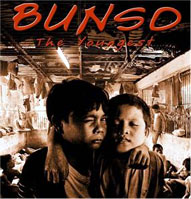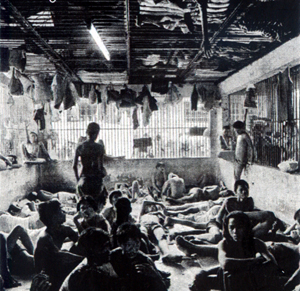
Lauren dragged me to watch a special viewing of Bunso (The Youngest) last saturday. Bunso is a poignant documentary film by Filmmakers Ditsi Carolino and Nana Buxani about three boys – Tony, 13, Diosel and Bunso, 11 – struggling to survive in a crowded Cebu jail alongside adult rapists and murderers. The two streetsmart boys paint us a picture into the surreal world of children caught between extreme poverty and the law.
These boys talked about their hunger and how they resorted to stealing just to survive. One boy stole from a sari-sari store because he could not bear the hunger pangs any longer. The owner did not press charges but the father wanted to teach his son a lesson by sending him to jail.
The boys are in prison for petty theft and robbery. Anthony claimed that he stole huge amounts of money to feed his family when his mother neglected his siblings. Bunso was on the streets because his mother did not “send him to school or care for him”. He resorted to begging for money at first, but when he couldn’t get any money, he stole. Then he started sniffing glue and needed more money to fund his addiction.
“I’d sniff first then eat,” he said in the film.

The verbal abuse and angry confrontations between Anthony’s parents are a symbol of this film’s reality. The kids live in slums at the prison. Their parents have no responsibility of caring for their children and leave them to feed and fend for themselves.
Children as young as 9 years old were sent to jail. The worst thing is that these kids were not segregated from the adult convicts. The jail conditions were horrible. I found out that the documentary was filmed in 2001, when Operation Second Chance, a jail facility in Cebu City for minors, was nearing completion. But for how long did these kids suffer living in these deplorable conditions? Food served to these kids looked worse than what pigs eat.
(Here is a snippet of the Bunso film)
As I watched the boys talk of their jail experience, I wanted to hug them and say that it is alright. You are just kids. You deserve a second chance. But what good are my words?
I was deeply troubled by the documentary that the moment I went home, I searched in the internet to see if anything was done to our children in Philippine Jails.
In May 16, 2006, the President signed into law, Juvenile Justice and Welfare Act of 2006. But are the kids given a second chance?
A year after the law is passed, children are still in jail. The Law enforcers continue to detain minors. Philippine Juvenile Justice Welfare Bill (RA 9344) is not being implemented.
As I watched Bunso, I wonder what their parents were thinking. Did they not feel any love for their kids? It’s not the child’s duty to provide food for their family. They should be playing, be at their homes or with friends at school.
I felt so helpless and troubled as their story unfolded. Sure, there is a law now but…
The law does not really solve the root cause.
The law does not pave opportunities for our children to grow properly.
The implementing rules and regulations does not eradicate poverty and generation of new jobs for the parents just so the kids don’t roam in the streets in search for food,
The Law does not strictly enforce the constitutional right of our children to free and quality education so that our kids will stay away from the streets.
The law does not enforce the value of responsible parenthood among parents.
Do we even need the Juvenile Justice and Welfare Act of 2006 if only these parents valued responsible parenthood?
Inspite of the lack of implementation from our law enforcers and the lack of interest from these parents, there is a glimmer of hope. Father Shay Cullen reports that the Peoples Recovery, Empowerment and Development Assistance Foundation, Inc. (PREDA) continue to save these kids from jail.
Outside they were clothed and fed and they were brought to the Preda Boys Home. Here, they are free to run about play basketball, swim, go to school, take an apprenticeship for trade. They learn right for wrong, grow in spiritual values and start life over. There is no need for walls, fences, gates or guards. The vast majority stays willingly and regains their pride, self-confidence and become good students. This June 2008, twenty-four have been enrolled in high school and another fifteen are taking distance learning. These are the throwaway children of the society, lost sheep whose rights were trampled underfoot but are now found and restored to a life of goodness and dignity.
Children need saving. Jail is no place for a child.
Lets do all we can to help end it once and for all.
Related Stories
Child inmates in Legazpi city jail have been serving more than their sentences
Kids Still Jailed in Manila – PREDA
(Photos from PREDA)
Noems, small world! Ditsi Carolino is the former UP Cebu (high school) classmate of Ruben. Harry Abilla (another classmate) told me all about her a couple of years ago because he felt her documentaries were worthwhile promoting in the Fil-Am communities. It’s too bad we weren’t able to connect.
I’ll forward this posting to one of my friends at Heartbridge International Foundation and Tulay ng Puso Foundation.
Lorna Dietzs last blog post..Cheapest internet airfares to the Philippines!
@lorna- i could hear her voice behind the interview. It must have been difficult for her to shoot this film because it was released only 2005.
I watched that documentary a few years ago. Shocking , riveting . I felt so much pity for the children who shouldn’t be there in the first place.
I don’t want to judge the parents but I can’t help it myself. Sana they didn’t give birth if they cannot take care of them. Also the Catholic church should be more lenient with birth control. Look at the poverty around that drives these parents to despair enough to neglect their children.
@Dina- I felt like crying. I am helpless but maybe through organizations like PREDA, we can help
@Lorraine- birth control would be a great option if the Catholic Church isn’t too strict on this matter. Poverty is a reality in our country and our government is incapable of providing solutions.
We’ve been showing this film to our student volunteers for three years now. It’s part of our formation track since one of our programs is a volunteer-teaching class in Dasmariñas Municipal Jail where we focus on the under-aged inmates, helping them get through the Alternative Learning Syste
The film is so powerful despite its age.
And last May, we also visited the Preda Foundation in Olongapo City. It was a great experience and help to us Lasallians in Cavite since we’ve already did the groundbreaking for our own youth-in-conflict-with-the-laws (YCLs) center in DLSUD. Soon, we’d be ready to take in troubled youths from all over Region IV and help them retake their lives and future.
jhays last blog post..Filipino Chemists/Inventors do we know more?
@jhay- am glad to know that your school is taking steps. WHile watching the movie, I kept shaking my head. Why are these kids not studying even in jail? Yes , we can start with our own region. I hope other regions establish their own programs.
Kudos to you and the student volunteers.
So young yet they have endured so much pain and suffering. How would they fare as adults, I don’t even want to think about it. I just ope that there would be people who would be able to help them start anew. Talk about starting a new life at such young age.
julies last blog post..Philippine Sea Tragedies
I saw this film last year for my CWTS class in NCPAG, and grabe talaga… it’s so saddening
Brians last blog post..Vegetarian Dinner
am glad there is a kind heart in Father Cullen. true, these kids do not deserve to just stay in jail–they need to be rehabilitated so that they could again be integrated into society and their families where they really belong.
Sexy Moms last blog post..Parenting–The risks I took (and continue to take)
@julie- at that age these kids should be under the comfort of their parents. I felt so bad for them. I felt like adopting them
@brian- my daughter felt so sad helpless. She wants to help these kids too. I found out about PREDA so maybe that’s where she can help.
@Dine- it’s good we have a Father Cullen, a non-government entity ready to help.
when i was younger, i wanted to work with kids like them… but even now that i’m older, i am still unsure whether I can effectively help because i’m bound to cry… maybe even feel despair myself, for their plight…
delishs last blog post..the high road
Interesting post! Is there a place I can buy this documentary online? Thanks in advance.
This is really something that our government should give a time to fix…
I, together with my classmates, are still questioning of how our law makers are too blind in understanding such situation that our country have been facing for years now…
This video was assigned to us as our MIDTERM exam will be based on this movie regarding the Human Rights of a Child.. While discussing this with my classmate, the sharer couldn’t help but cry because of her dismay with our government officials who suppossedly do their respective jobs of what the people paid them for, through our taxes.
This video has been the topic for days in two of our subject, the Human Right of the Child and in Criminal Law… Our professor couldn’t believe also about the Juvenile Jusctice Act of which no distinction was made by the law of a crime done by a child and an adult… The program may be different but in regards to their distinction, none….
While the adult will go to jail and the child goes to a somewhat called program, but no proper procedure as to how the program be implemented and this is something that is very disturbing because its implementation will be left to the people who might have the authority but will be powerless on how to face the situation…
wooohhh….
The bottom line is,
if the government is serious, give teeth to the wonderful laws and statutes that we have…
This is a problem not only to this situation but to almost all laws that have become white-elephant due to lack of implementation…
And also the problem with our people, no cooperation to the government and to their own selves… HAHAYSSSS…
======================================
R-a-M-u-J
ia a First year Law Student
University of San Carlos
Cebu City
…other people had seen that putting mischievous children in a jail as a good way of discipline….
…but for me it is not an effective way of disciplining them…
our professor once said that to discipline a child is not merely giving them pain and suffering so that they will not do it again….
instead show to them the right things to do…
show to them that you are a role model…
show to them that they can be what they are through you’re efficient and effective acts and thinks…